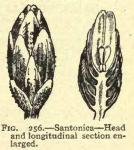 The dried unexpanded flower-heads of Artemis'ia pauciflo'ra Weber.
The dried unexpanded flower-heads of Artemis'ia pauciflo'ra Weber.
BOTANICAL CHARACTERISTICS.—A low, shrubby, tomentose, aromatic plant. Leaves downy, pinnatifid; flower-heads drooping, in dense thyrsoid panicles.
SOURCE.—Artemisia pauciflora grows on the desert plains or steppes of several parts of Russia, especially in the districts near the lower course of the Volga and Don Rivers. It is quite abundant in Persia and Turkestan, where it is known as Damanah. This Asiatic drug does not differ materially from the Russian, except that it is slightly shaggy and mixed with tomentose stalks. Of late years most of the wormseed of commerce has come from the steppes of the northern part of Turkestan, whence it finds its way to Moscow and Western Europe.
DESCRIPTION OF DRUG.—Greenish-brown, small, oblong-ovoid, about 2 mm. (⅛ in.) long. They consist of fifteen to eighteen imbricated scales, each having a green midrib containing oil-glands, which inclose four or five tubular florets so minute that they can scarcely be distinguished by the naked eye; odor strong, aromatic; taste bitter, aromatic, camphoraceous.
Powder.—Greenish-brown. Characteristic elements: Parenchyma cells, elongated, thin-walled; trichomes, glandular, 1 or 2 short cells or two or three pairs of cells, non-glandular, one-celled, long, slender, thin-walled; pollen mostly in masses, brown, 15 to 20 µ in diam.; pores distinct.
CONSTITUENTS.—Volatile oil about 1 per cent., having a characteristic smell and taste, devoid of anthelmintic properties, which reside in the neutral principle, santonin, C15H18O31. Santonin (Santonium, U. S.) constitutes about 2 per cent. of the drug; it occurs in colorless, rectangular, tabular crystals, which, when exposed to the light, assume a yellow hue. Soluble in 5300 parts of water, 34 of alcohol, 78 of ether and 2.5 of chloroform at 25°C. (77°F.).
Preparation of Santonin.—Digest powdered Santonica in dilute alcohol mixed with slaked lime; recover alcohol; add acetic acid in excess to residue, which separates santonin in white, shining, odorless bitter prisms, turning yellow on exposure.
This important principle is manufactured to a considerable extent in Russia, large factories at Oldberg turning out about twelve tons annually. It is well known to the natives of India, and is now imported from Germany. Much of the imported santonin is adulterated, sometimes to the extent of three-fourths of its weight, with gum and boric acid. These can easily be detected upon exposure as santonin turns yellow. The quantity of santonin in the plant diminishes as the plant grows older and the flowers expand.
Tests.—On dissolving with nitric acid and adding sulphuric acid we get a red color, and on adding Fe2Cl6 it changes to violet. With an alcoholic solution of KOH a pinkish-red liquid is obtained, soon becoming colorless.
On account of the fact that santonin is easily decomposed, it should be kept in amber-colored bottles, away from the sunlight, which converts it into yellow photo-santonic acid. Heating it with alkalies changes it into santoninic acid, while long boiling with baryta water changes it into santonic acid.
ACTION AND USES.—Anthelmintic. Dose; 15 to 60 gr. (1 to 4 Gm.), in infusion or electuary. Dose of santonin: ¼ to 1 gr. (0.016 to 0.065 Gm.), in powder or troches.
- Trochisci Santonini, U.S. VIII., ½ gr. (0.03 Gm.).

